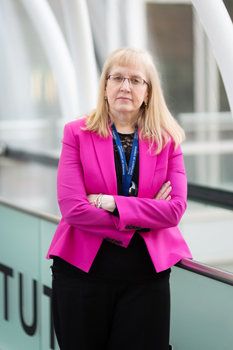Study suggests a gender gap in federal funding to scientists

By Ana Gajic

Dr. Sharon Straus
Female health scientists in Canada face a funding gap, suggests a new study published this month in The Lancet’s special issue, Advancing Women in Science, Medicine and Global Health. The research found that when grant reviewers can consider who is conducting the research, instead of solely focusing on the science itself, female researchers receive less funding.
Led by Dr. Holly Witteman, a human factors specialist in the faculty of medicine at Laval University in Quebec, the research team analyzed 24,000 grant applications to the Canadian Institutes for Health Research (CIHR). Dr. Sharon Straus, director of the Knowledge Translation program at the Li Ka Shing Institute of St. Michael’s and the interim physician-in-chief, was one of Witteman’s co-researchers.
We asked Dr. Straus to share some details about the study, its findings, and their significance.
Q. What did you set out to study?
In 2014, the CIHR created a natural experiment by creating two new grant programs from their existing researcher-initiated operating grant scheme. Specifically, they created the Foundation Grant scheme – in which the calibre of the Principal Investigator is explicitly reviewed. They also created the Project scheme – in which the calibre of the Principal Investigator is not the explicit focus of the review and instead it is the ‘science’ described in the research proposal that is reviewed.
We analyzed all investigator-initiated CIHR grant competitions between 2011 and 2016 to determine the application success between male and female Principal Investigators across the two different review processes.
Q. Why were you interested in this topic?
Studies from various countries have shown that male researchers receive more research funding than their female peers. These studies have largely been observational, which means that it’s unclear if imbalances in funding are due to evaluations of female researchers or of their proposed research. The CIHR natural experiment allowed us to study this with more clarity.
Q. What were the key findings?
We found a gender gap in grant funding. In particular, we found that the gender gap in grant funding was attributable to women being evaluated less favourably as principal investigators, not from differences in the quality of the research proposals led by men and women.
Q. Why are these findings important?
Funders should ensure that the best research is funded. This is of particular importance when research is publicly funded and it is critical to show value for money.
Bias in grant review prevents the best research from being funded. If bias persists, critical research advances can be overlooked and researchers’ careers can be derailed.
Q. What do you hope comes from this research?
We hope all funders of research everywhere attempt to ensure that their grant programs do not reproduce or exacerbate biases that lead to gender gaps in funding. They should make efforts to break gender biases amongst reviewers and should focus on competitions that assess the science, not individuals.
Q. What do you see as the impact of a special issue of The Lancet focused on advancing women in science, medicine and global health?
It was terrific to participate in the launch of the theme issue in London. The conversation focused on institutional/systemic interventions to advance diversity in science and medicine and how to measure their impact. It was not about ‘fixing the women’ but instead about fixing the system. Each attendee was challenged to document what they propose to tackle in their organization over the next three months.
Richard Horton, editor of The Lancet, announced that this was just the beginning, and I look forward to seeing their next theme issue, which I hope will include more studies of interventions showing effective strategies to advance women in science and medicine.
Disclosure note: Dr. Sharon Straus has received funding from CIHR consistently since being on Faculty and holds a Foundation Grant.
These papers are an example of how St. Michael’s Hospital is making Ontario Healthier, Wealthier, Smarter.
About St. Michael’s Hospital
St. Michael’s Hospital provides compassionate care to all who enter its doors. The hospital also provides outstanding medical education to future health care professionals in more than 29 academic disciplines. Critical care and trauma, heart disease, neurosurgery, diabetes, cancer care, care of the homeless and global health are among the Hospital’s recognized areas of expertise. Through the Keenan Research Centre and the Li Ka Shing International Healthcare Education Centre, which make up the Li Ka Shing Knowledge Institute, research and education at St. Michael’s Hospital are recognized and make an impact around the world. Founded in 1892, the hospital is fully affiliated with the University of Toronto.
About Unity Health Toronto
Unity Health Toronto, comprised of Providence Healthcare, St. Joseph’s Health Centre and St. Michael’s Hospital, works to advance the health of everyone in our urban communities and beyond. Our health network serves patients, residents and clients across the full spectrum of care, spanning primary care, secondary community care, tertiary and quaternary care services to post-acute through rehabilitation, palliative care and long-term care, while investing in world-class research and education. For more information, visit www.unityhealth.to.
